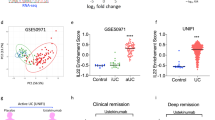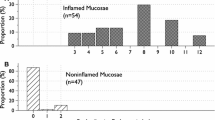Abstract
Background
Ulcerative colitis is characterized by relapsing mucosal inflammation where the lesions include tissue-damaging granulocytes. In addition, T cells and natural killer (NK) cells play important pathophysiologic roles. Chemokines are a large family of peptides that play key roles in the regulation of inflammation. The CXC-chemokines, growth-related oncogene (GRO)-α/CXCL1 and interleukin (IL)-8/CXCL8, both recruit neutrophils and possess mitogenic properties, whereas the interferon-dependent CXC-chemokines monokine induced by gamma-interferon (MIG)/CXCL9, interferon-γ inducible protein of 10 kD/CXCL10, and IFN-inducible T cell alpha chemoattractant/CXCL11 recruit and activate T cells and NK cells.
Materials and methods
The expression of CXC-chemokines was studied in eight controls and in 11 patients suffering from ulcerative colitis in the distal part of the colon, before and during topical treatment with corticosteroids. Perfusates (obtained before, after 7 days, and after 28 days of treatment) and pinch biopsies (obtained before and after 28 days of treatment) were collected by colonoscopy. The rectal release of GRO-α and MIG was determined by enzyme-linked immunosorbent assay (ELISA), and tissue expression of the chemokines was detected in colonic tissue by immunohistochemistry.
Results
In perfusates, high levels of GRO-α, IL-8, and MIG were detected compared with controls (p = 0.02, 0.005, and p = 0.03, respectively). During treatment with corticosteroids, both GRO-α and MIG decreased. In clinical nonresponders, characterized by sustained inflammation, the levels of GRO-α and MIG remained elevated. Both epithelial cells and granulocytes, present in the submucosa, expressed GRO-α and MIG as detected by immunohistochemistry.
Conclusions
CXC-chemokines are likely to be important in the pathophysiology of ulcerative colitis and may become targets for novel treatment strategies. In addition, GRO-α may serve as a marker of disease activity.



Similar content being viewed by others
References
Podolsky DK (2002) Inflammatory bowel disease. N Engl J Med 347:417–429
Elliott SN, Wallace JL (1998) Neutrophil-mediated gastrointestinal injury. Can J Gastroenterol 12:559–568
Egesten A, Andersson P, Persson T (2002) Eosinophils in gastrointestinal inflammation: from innocent bystanders to offenders. Scand J Gastroenterol 37:1117–1125
Camoglio L, Te Velde AA, Tigges AJ, Das PK, Van Deventer SJ (1998) Altered expression of interferon-gamma and interleukin-4 in inflammatory bowel disease. Inflamm Bowel Dis 4:285–290
Fuss IJ, Heller F, Boirivant M, Leon F, Yoshida M, Fichtner-Feigl S, Yang Z, Exley M, Kitani A, Blumberg RS, Mannon P, Strober W (2004) Nonclassical CD1d-restricted NK T cells that produce IL-13 characterize an atypical Th2 response in ulcerative colitis. J Clin Invest 113:1490–1497
Baggiolini M (2001) Chemokines in pathology and medicine. J Intern Med 250:91–104
Luster AD (2001) Chemokines regulate lymphocyte homing to the intestinal mucosa. Gastroenterology 120:291–294
Wen DZ, Rowland A, Derynck R (1989) Expression and secretion of gro/MGSA by stimulated human endothelial cells. EMBO J 8:1761–1766
Sauty A, Dziejman M, Taha RA, Iarossi AS, Neote K, Garcia-Zepeda EA, Hamid Q, Luster AD (1999) The T cell-specific CXC chemokines IP-10, Mig, and I-TAC are expressed by activated human bronchial epithelial cells. J Immunol 162:3549–3558
Persson-Dajotoy T, Andersson P, Bjartell A, Calafat J, Egesten A (2003) Expression and production of the CXC chemokine growth-related oncogene-alpha by human eosinophils. J Immunol 170:5309–5316
Jinquan T, Jing C, Jacobi HH, Reimert CM, Millner A, Quan S, Hansen JB, Dissing S, Malling HJ, Skov PS, Poulsen LK (2000) CXCR3 expression and activation of eosinophils: role of IFN-gamma-inducible protein-10 and monokine induced by IFN-gamma. J Immunol 165:1548–1556
Addison CL, Daniel TO, Burdick MD, Liu H, Ehlert JE, Xue YY, Buechi L, Walz A, Richmond A, Strieter RM (2000) The CXC chemokine receptor 2, CXCR2, is the putative receptor for ELR+ CXC chemokine-induced angiogenic activity. J Immunol 165:5269–5277
Romagnani P, Annunziato F, Lasagni L, Lazzeri E, Beltrame C, Francalanci M, Uguccioni M, Galli G, Cosmi L, Maurenzig L, Baggiolini M, Maggi E, Romagnani S, Serio M (2001) Cell cycle-dependent expression of CXC chemokine receptor 3 by endothelial cells mediates angiostatic activity. J Clin Invest 107:53–63
Cole AM, Ganz T, Liese AM, Burdick MD, Liu L, Strieter RM (2001) IFN-inducible ELR− CXC chemokines display defensin-like antimicrobial activity. J Immunol 167:623–627
Ekbom A, Helmick C, Zack M, Adami HO (1990) Ulcerative colitis and colorectal cancer. A population-based study. N Engl J Med 323:1228–1233
Sangfelt P, Carlson M, Thorn M, Lööf L, Raab Y (2001) Neutrophil and eosinophil granule proteins as markers of response to local prednisolone treatment in distal ulcerative colitis and proctitis. Am J Gastroenterol 96:1085–1090
Binder V (1979) A comparison between clinical state, macroscopic and microscopic appearances of rectal mucosa, and cytologic picture of mucosal exudate in ulcerative colitis. Scand J Gastroenterol 5:627–632
Truelove SC, Richards WC (1956) Biopsy studies in ulcerative colitis. Br Med J 1:1315–13188
Cordell JL, Falini B, Erber WN, Ghosh AK, Abdulaziz Z, MacDonald S, Pulford KA, Stein H, Mason DY (1984) Immunoenzymatic labeling of monoclonal antibodies using immune complexes of alkaline phosphatase and monoclonal anti-alkaline phosphatase (APAAP complexes). J Histochem Cytochem 32:219–229
Sangfelt P, Carlson M, Thorn M, Xu S, Loof L, Raab Y (2002) Local release of human neutrophil lipocalin (HNL), IL-8, and TNF-alpha is decreased as response to topical prednisolone treatment in distal ulcerative colitis and proctitis. Dig Dis Sci 47:2064–2069
Keshavarzian A, Fusunyan RD, Jacyno M, Winship D, MacDermott RP, Sanderson IR (1999) Increased interleukin-8 (IL-8) in rectal dialysate from patients with ulcerative colitis: evidence for a biological role for IL-8 in inflammation of the colon. Am J Gastroenterol 94:704–712
Uguccioni M, Gionchetti P, Robbiani DF, Rizzello F, Peruzzo S, Campieri M, Baggiolini M (1999) Increased expression of IP-10, IL-8, MCP-1, and MCP-3 in ulcerative colitis. Am J Pathol 155:331–336
Borregaard N, Cowland JB (1997) Granules of the human neutrophilic polymorphonuclear leukocyte. Blood 89:3503–3521
Egesten A, Eliasson M, Johansson HM, Olin AI, Mörgelin M, Mueller A, Pease JE, Frick IM, Björck L (2007) The CXC chemokine MIG/CXCL9 is important in innate immunity against Streptococcus pyogenes. J Infect Dis 195:684–693
Lee J, Horuk R, Rice GC, Bennett GL, Camerato T, Wood WI (1992) Characterization of two high affinity human interleukin-8 receptors. J Biol Chem 267:16283–16287
Ahuja SK, Murphy PM (1996) The CXC chemokines growth-regulated oncogene (GRO) alpha, GRObeta, GROgamma, neutrophil-activating peptide-2, and epithelial cell-derived neutrophil-activating peptide-78 are potent agonists for the type B, but not the type A, human interleukin-8 receptor. J Biol Chem 271:20545–20550
Loukinova E, Dong G, Enamorado-Ayalya I, Thomas GR, Chen Z, Schreiber H, Van Waes C (2000) Growth regulated oncogene-alpha expression by murine squamous cell carcinoma promotes tumor growth, metastasis, leukocyte infiltration and angiogenesis by a host CXC receptor-2 dependent mechanism. Oncogene 19:3477–3486
Keane MP, Belperio JA, Xue YY, Burdick MD, Strieter RM (2004) Depletion of CXCR2 inhibits tumor growth and angiogenesis in a murine model of lung cancer. J Immunol 172:2853–2860
Pan J, Burdick MD, Belperio JA, Xue YY, Gerard C, Sharma S, Dubinett SM, Strieter RM (2006) CXCR3/CXCR3 ligand biological axis impairs RENCA tumor growth by a mechanism of immunoangiostasis. J Immunol 176:1456–1464
Lang KS, Georgiev P, Recher M, Navarini AA, Bergthaler A, Heikenwalder M, Harris NL, Junt T, Odermatt B, Clavien PA, Pircher H, Akira S, Hengartner H, Zinkernagel RM (2006) Immunoprivileged status of the liver is controlled by Toll-like receptor 3 signaling. J Clin Invest 116:2456–2463
Podolin PL, Bolognese BJ, Foley JJ, Schmidt DB, Buckley PT, Widdowson KL, Jin Q, White JR, Lee JM, Goodman RB, Hagen TR, Kajikawa O, Marshall LA, Hay DW, Sarau HM (2002) A potent and selective nonpeptide antagonist of CXCR2 inhibits acute and chronic models of arthritis in the rabbit. J Immunol 169:6435–6444
Acknowledgments
We are grateful for statistical advice from Mikael Åström, technical assistance of Pia Andersson, and linguistic revision by Dr. Alan Chester. The study was supported by grants from The Bergh, Grönberg, Ihre, Julin, Kock, and Österlund foundations.
Competing interests
None declared.
Author information
Authors and Affiliations
Corresponding author
Rights and permissions
About this article
Cite this article
Egesten, A., Eliasson, M., Olin, A.I. et al. The proinflammatory CXC-chemokines GRO-α/CXCL1 and MIG/CXCL9 are concomitantly expressed in ulcerative colitis and decrease during treatment with topical corticosteroids. Int J Colorectal Dis 22, 1421–1427 (2007). https://doi.org/10.1007/s00384-007-0370-3
Accepted:
Published:
Issue Date:
DOI: https://doi.org/10.1007/s00384-007-0370-3




